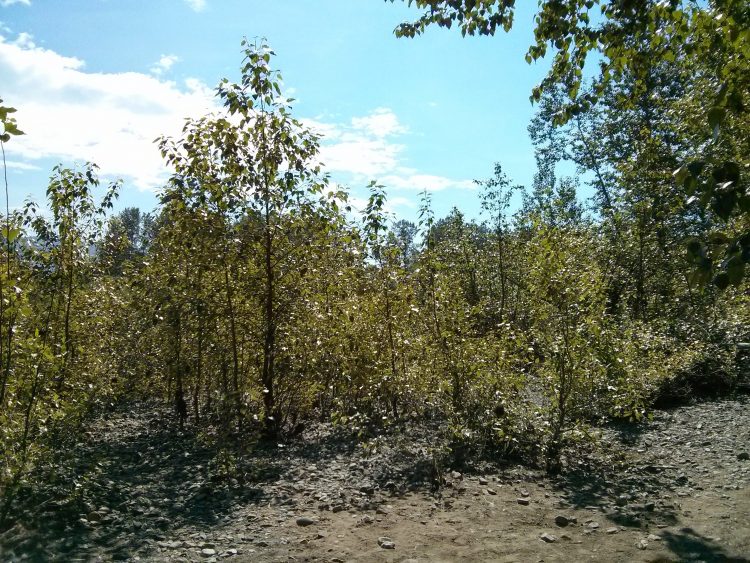Seattle, Washington, USA
November 24, 2020

Poplar trees such as these along the Snoqualmie River able to thrive on rocky riverbanks, despite low availability of nutrients like phosphorus in their natural habitat. Microbes help these trees capture and use the nutrients they need for growth.Sharon Doty/University of Washington
Phosphorus is a necessary nutrient for plants to grow. But when it’s applied to plants as part of a chemical fertilizer, phosphorus can react strongly with minerals in the soil, forming complexes with iron, aluminum and calcium. This locks up the phosphorus, preventing plants from being able to access this crucial nutrient.
To overcome this, farmers often apply an excess of chemical fertilizers to agricultural crops, leading to phosphorus buildup in soils. The application of these fertilizers, which contain chemicals other than just phosphorus, also leads to harmful agricultural runoff that can pollute nearby aquatic ecosystems.
Now a research team led by the University of Washington and Pacific Northwest National Laboratory has shown that microbes taken from trees growing beside pristine mountain-fed streams in Western Washington could make phosphorus trapped in soils more accessible to agricultural crops. The findings were published in October in the journal Frontiers in Plant Science.
Endophytes, which are bacteria or fungi that live inside a plant for at least some of their lifecycle, can be thought of as “probiotics” for plants, said senior author Sharon Doty, a professor in the UW School of Environmental and Forest Sciences. Doty’s lab has shown in previous studies that microbes can help plants survive and even thrive in nutrient-poor environments — and help clean up pollutants.
In this new study, Doty and collaborators found that endophytic microbes isolated from wild-growing plants helped unlock valuable phosphorus from the environment, breaking apart the chemical complexes that had rendered the phosphorus unavailable to plants.

As an endophytic strain dissolves tricalcium phosphate, a clear halo is produced around the milky-white phosphate circles, as seen in this image of the process occurring in an agar medium.Sharon Doty/University of Washington
“We’re harnessing a natural plant-microbe partnership,” Doty said. “This can be a tool to advance agriculture because it’s providing this essential nutrient without damaging the environment.”
Doty’s research scientist, Andrew Sher, and UW undergraduate researcher Jackson Hall demonstrated in lab experiments that the microbes could dissolve the phosphate complexes. Poplar plants inoculated with the bacteria in Doty’s lab were sent to collaborator Tamas Varga, a materials scientist at the Environmental Molecular Sciences Laboratory at Pacific Northwest National Laboratory in Richland, Washington. There researchers used advanced imaging technologies at their lab and at other U.S. Department of Energy national laboratories to provide clear evidence that the phosphorus made available by the microbes did make it up into the plant’s roots.
The imaging also revealed that the phosphorus gets bound up in mineral complexes within the plant. Endophytes, living inside plants, are uniquely positioned to re-dissolve those complexes, potentially maintaining the supply of this essential nutrient.
While previous work in Doty’s lab demonstrated that endophytes can supply nitrogen, obtained from the air, to plants, such direct evidence of plants using phosphorus dissolved by endophytes was previously unavailable.
The bacteria used in these experiments came from wild poplar trees growing along the Snoqualmie River in Western Washington. In this natural environment, poplars are able to thrive on rocky riverbanks, despite low availability of nutrients like phosphorus in their natural habitat. Microbes help these trees capture and use the nutrients they need for growth.
These findings can be applied to agriculture crops, which often sit, unused, on an abundance of “legacy” phosphorus that has accumulated in the soil, unused, from years of fertilizer applications. Microbes could be applied in the soil among young crop plants, or as a coating on seeds, helping to unlock phosphorus held captive and making it available for use by plants to grow. Reducing the use of fertilizers and employing endophytes — such as those studied by Doty and Varga — opens the door for more sustainable food production.
“This is something that can easily be scaled up and used in agriculture,” Doty said.
UW has already licensed the endophyte strains used in this study to Intrinsyx Bio, a California-based company working to commercialize a collection of endophyte microbes. The direct evidence provided by Doty and Varga’s research of endophyte-promoted phosphorus uptake is “game-changing for our research on crops,” said John Freeman, chief science officer of Intrinsyx Bio.
Co-authors are Kim Hixson, Amir Ahkami, Rosalie Chu, Anil Battu, Loren Reno, Carrie Nicora and Tanya Winkler of Pacific Northwest National Laboratory; Morgan Barnes of the University of California, Merced; Sirine Fakra and Dilworth Parkinson of Lawrence Berkeley National Laboratory; and Olga Antipova of Argonne National Laboratory.
This research was funded by the Byron and Alice Lockwood Foundation and the U.S. Department of Energy Office of Science.
For more information, contact Doty at sldoty@uw.edu.
See a related story from the Environmental Molecular Sciences Laboratory.